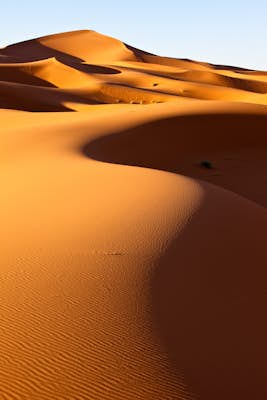From golden sand dunes to the lofty peaks of the High Atlas mountains, Morocco is an adventurer’s dream. Epic landscapes carpet this slice of North Africa like the richly patterned rugs you’ll lust after in the souqs.
On lower ground, windswept coastlines, waterfalls and caves are tucked into forested hills and verdant palm oases. Here are Morocco’s top 10 natural wonders.
Editor’s note: Please check the latest travel restrictions before planning any trip and always follow government advice.
Erg Chebbi
Shape-shifting over 17 miles from north to south and reaching heights of 525 feet, the great sand sea of Erg Chebbi is extraordinarily scenic. The rose-gold dunes rise dramatically above a pancake-flat, grey hamada (hard-packed rocky desert) and turn stunning shades of orange, pink and purple as the sun sets.
Plage Sauvage
Two-and-a-half miles south of Mirleft is this truly wild beach, accessible down a set of steps, featuring caves, cliffs and crashing waves great for surfing. There’s an outpost of Spot-M here for board and wetsuit rental, and Biscou Surf School also brings students here. But the beach is gorgeous and the ocean relatively mild, whether or not you’re riding a board.

High Atlas Mountains
Welcome to North Africa’s highest mountain range, known by Imazighen (Berbers) as “Idraren Draren” (Mountains of Mountains), and a trekker’s paradise from spring to autumn. The range runs diagonally across Morocco for almost 625 miles, encircling Marrakesh to the south and east from the Atlantic Coast just north of Agadir to Khenifra in the northeast. Its saw-toothed peaks act as a weather barrier between the mild, Mediterranean climate to the north and the Sahara to the south.
For rafters and kayakers, the valley is a green jewel where rafts whip between 8.3ft-wide limestone walls; for climbers and trekkers, the extreme topography and huge routes offer ridiculous views and a thrilling sense of wilderness.
The best hikes in Morocco’s High Atlas Mountains
Jebel Toubkal
For pure mountain air that cuts through the heat and leaves you dizzy, don’t miss the highest mountain in North Africa: snowcapped Jebel Toubkal (13671 ft), situated in the heart of the Toubkal National Park. Mountain trails criss-crossing the range start from Imlil, which is located at the source of the Mizane River.
How to climb Toubkal, Morocco’s highest peak

Erg Chigaga
There’s not a single sand dune (erg) found at the misnamed Erg Chigaga, instead, there is an incredible stretch of golden sand sea some 35 miles southwest of M’Hamid. It is the largest sand sea in Morocco, snaking along the horizon for 25 miles and bordered to the north and south by mountain ridges. The best way to get here is in classic movie style: by camel (from Dh500 to Dh600 per day), which takes between five and seven days round-trip.
Gouffre de Friouato
More than 66ft wide and 755ft deep, the Gouffre de Friouato is said to be the deepest cavern in North Africa, and the cave system is possibly the most extensive. It was first investigated in 1935, and access leads down 520 precipitous steps (with handrails) to the floor of the cavern.
Once you reach the bottom of the stairs, you can squeeze through a hole to start exploring the fascinating chambers that are found 200 more steps below. It’s dark and eerily beautiful.
The most spectacular chambers, full of extraordinary formations, are the Salle de Lixus and the Salle de Draperies. They do indeed resemble thin sheets of curtains, frozen and calcified. Speleologists have explored to a depth of 984ft, and they believe there are more rooms another 1640ft below.

Cascades d’Ouzoud
The many-tiered Cascades d’Ouzoud are stunningly beautiful, with several distinct falls, the largest a massive 328ft drop. The area is also one of the most popular day trips from Marrakesh, so be prepared to not have this natural idyll to yourself.
On summer weekends the cafe-lined paths that lead down to the falls are filled with local families and tourists browsing souvenir stalls and taking pictures. To reach the falls, walk past the signs for Riad Cascades d’Ouzoud towards the precipice, where converging paths wind down towards the largest falls and beyond.

Oualidia
Oualidia (wa-lid-ee-ah) is a gorgeous crescent-shaped lagoon fringed with golden sands and protected from the wild surf by a rocky breakwater.
With great fish and seafood – the town is renowned for its oysters – and a range of accommodation options, it’s a popular weekend and summer retreat for Marrakshis and Casablancais, and the perfect destination for those in need of a break from the city hubbub.
Outside July and August, it’s quiet, with little more to do than relax, surf and gorge on shellfish. In spring and autumn, birdwatchers arrive to observe migrating pink flamingos, terns, egrets and more on the lagoon and surrounding coastal wetlands.
Iriqui National Park
Morocco’s largest national park – covering a landmass of 303,940 acres – and uniquely Saharan, Iriqui was created in 1994 to protect the biodiversity of this wild region of arid savanna, dunes and salt flats and, in particular, the ephemeral wetlands of Lake Iriqui which attracts migratory birds during the winter rainy season. It’s around 55 miles of off-road driving from Foum Zguid, but can be visited as part of a tour to or from Erg Chigaga.
Rif Mountains
The Rif (reef) is the greenest and most northerly of Morocco’s mountain chains. It’s an excellent place to explore, especially on foot. There are plenty of good hikes, particularly in Talassemtane National Park.
You might also like:
Why you should embrace Berber culture on your Moroccan adventure
Essential Morrocan experiences you won’t want to miss
Hidden Marrakesh: a guide to the city’s best-kept secrets
